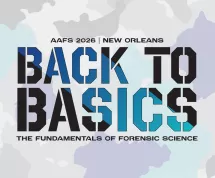Search
Explore content from JFS, ASB, the AAFS Newsfeed, and other content using the search bar or filters.
Commentary on: Morgon J. Wrongful convictions and claims of false or misleading forensic...
Knowledge of child abuse and neglect in nursing students: Assessment and perspectives
Misdiagnosis of child abuse and neglect can delay early treatment. Some authors have pointed out that nurses can miss child abuse and neglect diagnoses due to a lack of knowledge. It is unclear whether the lack of knowledge is due to students' insufficient preparation in nur...

Purdue University Hosting Cold Case Symposium October 2023
Family Closure Through Forensic Odontology
Closing Time! Submit Your Nominations for the Carrie Morgan Whitcomb Outstanding Service...
Rapid detection of synthetic cannabinoid receptor agonists impregnated into paper by...
The last few years have witnessed the change in the modalities of smuggling of synthetic cannabinoid receptor agonists (SCRAs) by impregnating them in mail envelopes and fast parcels. Considering the aforementioned scenario, it is important to develop a portable technique to iden...
2023–24 Warren-Young Scholarship Recipient Announced

Form follows function: Applying photographic content analysis to forensic firearm...
Drawing forensic conclusions from an image or a video is known as "photographic content analysis." It involves the analysis of an image, as well as objects, actions, and events depicted in images or video. In recent years, photographic depictions of objects suspected as...
Patient termination of a life‐sustaining medical device: Suicide or natural death?
Medical technology has made tremendous strides in extending the lives of patients who have suffered organ failure. Machines can now replace the function of the kidneys, the heart, and other vital organs. Much has been written about a patient's right to refuse or direct the w...
Changes in methamphetamine impurity profiles induced by tert‐butoxycarbonylation
Analysis of impurities in methamphetamine (MA) can be used to characterize MA seizures, investigate the relationship among MA seizures, and provide information on their synthetic routes. Recently, chemically derivatized MA, such as tert‐butoxycarbonyl (t‐Boc) MA, has been seized ...
Practical benzylation of N,N‐substituted ethanolamines related to chemical warfare agents...
The benzylation of three low molecular weight N,N‐disubstituted ethanolamines related to chemical warfare agents (CWAs) to furnish derivatives with improved gas chromatography‐mass spectrometry (GC‐MS) profiles is described. Due to their low molecular weight and polar nature, N,N...
Detection and confirmation of fentanyls in high clay‐content soil by electron ionization...
Detection of illicit drugs in the environment, particularly in soils, often suggests the present or past location of a clandestine production center for these substances. Thus, development of efficient methods for the analysis and detection of these chemicals is of paramount impo...
President's Spotlight—Mid-Year Meeting Report
Book Early, Stay Late! AAFS 2024 Hotel Update
Sydney Declaration Survey
Field‐portable detection of fentanyl and its analogs: A review
The need to detect fentanyl and its analogs in the field is an important capability to help prevent unintentional exposure or overdose on these substances, which may result in death. Many portable methods historically used in the field by first responders and other field users to...
Attendees

Clandestine Synthesis of Methamphetamine: An Overview
